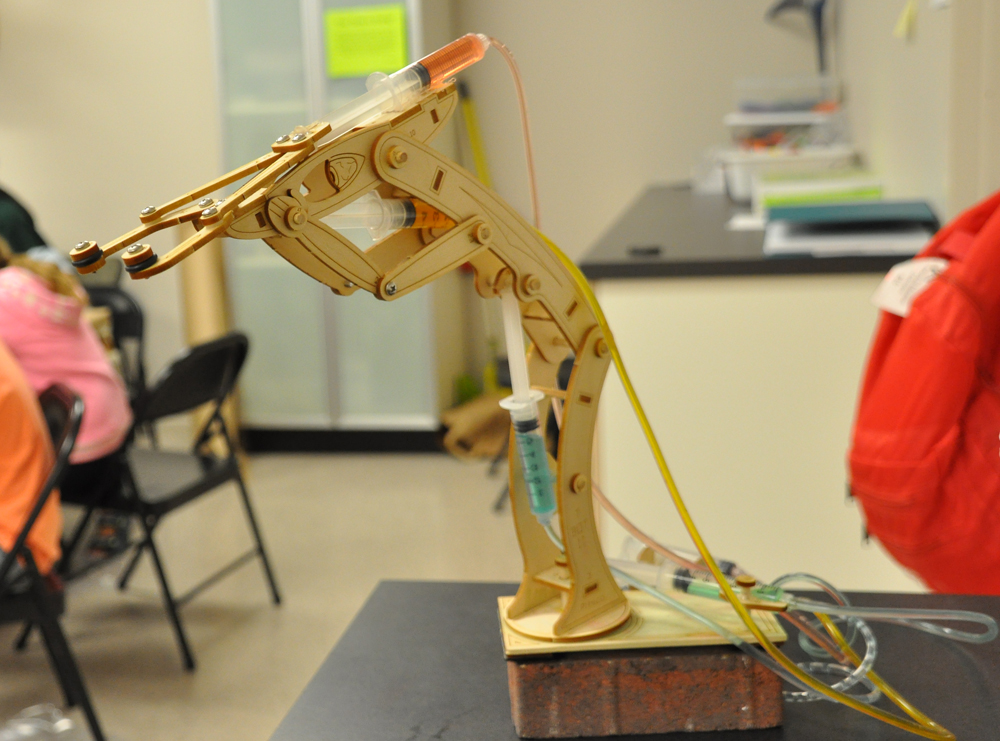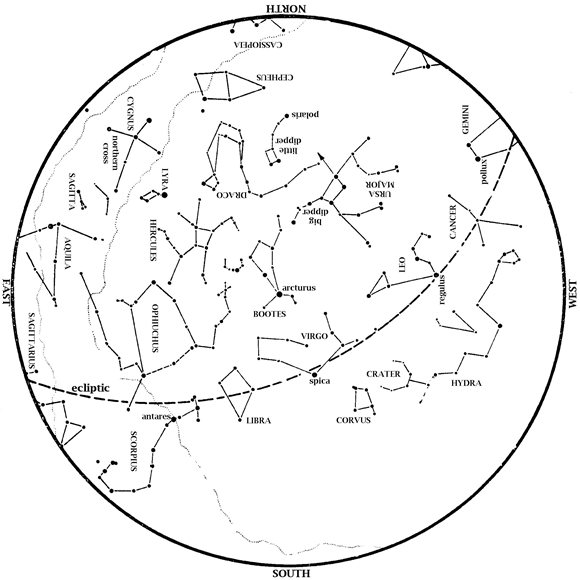What do you get when you throw a 30-year-old copywriter into a summer camp classroom full of 10-year-olds?

Sticking out like an aqua-colored sore thumb in Karen Culbertson’s “Leonardo’s Workshop” class at Xplorations Summer Camp. Photo by: Mary Martha Meyer-Hill
A lot of weird looks and kids asking, “Miss, does he actually think he’s 10 years old? Is that why he’s here?”
That, and an aqua T-shirt.
Since Xplorations Summer Camp is in its final swing at the end of this summer (only two weeks left after this one!), I decided it was time I looked into what those brilliant teachers are showing all our curious campers. VP of Youth Education Nicole Temple placed me in a class for a day as sort of an “undercover reporter,” but the kids weren’t buying it. Maybe it’s because I’m six feet tall or have a beard. And here I was starting to believe those people who said I look young for my age. Guess good skin will only take you so far.
In the “Leonardo’s Workshop” summer camp, I studied with a class of about 25 students, delving into the mechanics of pressure under the tutelage of Karen Culbertson. We learned about pneumatics, the science behind the reason tires inflate to support tons of machinery, and hydraulics, using water to drive moving parts. A bad student since way back, I arrived late to class. Camp starts at 10 a.m., and I was there around 10:45. I missed the lecture about the work of Leonardo da Vinci (the Renaissance mind responsible for strange flying machines, paintings, sculpture, and the Vitruvian Man), but I was just in time to join the class in making a few hypotheses about our first science experiment.

Working together in groups to share ideas is a big part of learning at camp, and part of the fun. Photo by: Mary Martha Meyer-Hill
After finding the nearest empty seat and awkwardly introducing myself to my table, my group partners caught me up on what I’d missed. The day prior, they made a glider, which seems easy enough, but the challenge was they weren’t allowed to throw it. They could only drop it off a ledge, and it was supposed to soar on its own.
I expressed my doubts. “No way! Really? That sounds impossible.”
“It wasn’t that hard,” the kid across from me said with a confident shrug.
I felt intimidated. They already thought I was dumb for being a student in a class someone my age should be teaching. Could I pull this off? Would I get in trouble if I didn’t perform?
I decided to mind my P’s and Q’s and pay attention, taking careful notes. Ms. Culbertson taught us that pneumatics (careful on the spelling) is the science that deals with compressed air.
“Do you ever wonder how a tire holds up a car?”
Come to think of it, I did.
“Do you think it’s the rubber or the air that supports the weight?”
I hesitated to answer, fearful that I’d look stupid, and let the class give the correct response. “It’s the air!”
“Good. Now we’re going to see how it works.”
Ms. Culbertson’s helpers gave us straws, masking tape, and a gallon-sized plastic freezer bag. We were told to tape the bag shut with the straw inside, and she encouraged us to get creative with solving the problem of preventing any leaks. I thought it would be clever to tape the straw in one corner of the zipper closure to minimize leaks, but it didn’t work. (Here’s a tip: even when the zipper is closed and the tape surrounds the straw, the air can still leak out if you don’t seal the lip.) So I taped the whole thing shut. I saw the other kids following my example, and then I started to feel cool, like an accepted part of the group.
When our bags were sealed, Ms. Culbertson had us stack our notebooks on top of them and witness the power of an inflated chamber. We found we could lift several pounds of weight with just a flexible piece of clear plastic supported with air pressure. Pretty darn cool to see pneumatics in action!

One of my camp buddies and I watched how marine biologists tag great white sharks with GPS trackers. Photo by: Mary Martha Meyer-Hill
After the experiment, we headed out of the classroom on a field trip to the Shark! exhibit, where we got wet touching live bamboo and epaulette sharks. (Here’s another tip: use only two fingers and don’t grab the sharks. You can hurt them or get hurt yourself, and the marine biologists will yell at you. This didn’t happen to me; I’m just saying…) When you run your fingers from nose to tail, the sharks’ skins are smooth, but from tail to tip, it’s like sandpaper. Ms. Culbertson explained that the reason for the rough skin is to make the sharks more “aerodynamic,” a lot like the gliders her class made the day before, but in water. Their skin and torpedo shape makes sharks some of the best swimmers in the ocean.

The docile bamboo sharks in the Shark! Touch Tank Experience exhibit feel smooth or like sandpaper, depending on which direction you pet them. Photo by: Mary Martha Meyer-Hill
We stayed in the exhibit and watched some footage of field biologists tagging great whites, compared the jaws of a modern shark to the giant maw of the extinct megalodon, and learned that sharks aren’t as dangerous as they seem. Even though attacks can sometimes be grisly, they don’t happen often, and it’s pretty rare to die from a shark bite. Sharks would rather eat fish than people. To them, we taste gross. Info on text panels told the tragic story of finning, which is killing millions of sharks a year, driving them toward the endangered species list.

Information on text panels explained the plight of the great white shark, being driven to an endangered species by the global finning industry. Photo by: Mary Martha Meyer-Hill
After a 45-minute lunch watching the Magic School Bus and chatting with some college-level facilitators closer to my own age (the one time I broke character), we returned to the classroom for the highlight of my adventure as a camper. By then I had made some friends.

A wooden hydraulic arm gave us something to aspire to in our engineering science experiment. Syringes filled with water and food coloring drive its moving parts. Photo by: Mary Martha Meyer-Hill
With pneumatics behind us, Ms. Culbertson turned the class to hydraulics. Her assistants gave us each a length of surgical tubing and two syringes (without the needles, of course). We submerged all the elements in a bucket of water and assembled them, one syringe plunger-down and the other plunger-up. If you do it right, when you take it out of the water, you can press one plunger down and the hydraulic pressure forces the other plunger up. It was the basic mechanical element that allowed us to build a robotic arm.

The basic hydraulic arm we assembled was much simpler, but no less cool. Photo by: Mary Martha Meyer-Hill
Ms. Culbertson showed us a fancy wooden arm build from a kit to give us inspiration. Four syringes powered it, and depending on which assembly you activated, it would grip, descend, move side to side or bend its “wrist.” There was no way any of us could have made something like that without a set of instructions, but the demonstration gave us enough ideas to build a basic hinge out of cardboard cut-outs and duct tape.
Using the same parts, each of us came up with a different model. One camper made what I named a “waving machine,” attaching a hand-shaped cutout to the end of his arm, while I and another student taped a green marker to the end of my hydraulic “arm” to make a sort of writing machine. Many other designs proved that the imagination is limitless. Some were successful, while others needed work, but with da Vinci’s lessons of constant innovation in mind, Ms. Culbertson pushed everyone to keep trying to improve their designs.
By then, it was 2 p.m. and time for me to go back to work in my boring old office cubicle. Back to adult life. Still, as I shared the adventure with several of my co-workers, it was difficult not to feel child-like excitement.
There’s only two weeks left to register for Xplorations Summer Camp at HMNS. If I learned something, made friends, and had fun, any kid will! With many other exciting themes to choose from like Crime Scene Investigators, Star Warrior’s Academy, Mummies and Mysteries, and Dino Claws and Shark Jaws, there’s tons of stuff to learn about and experiments to do.
Shoot. Come to think of it, maybe I’ll go back myself.







